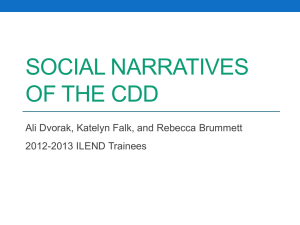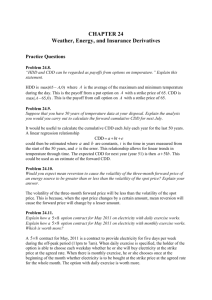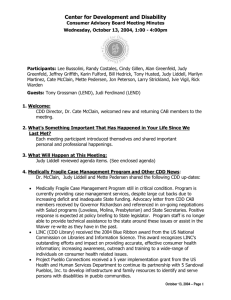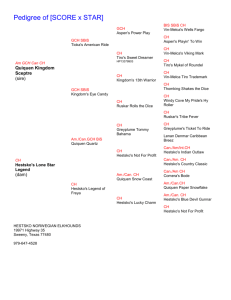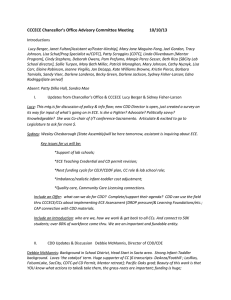An Analytical Study of Cooperative Data Dissemination in Push-based Mobile Environments Chengcheng Dai
advertisement
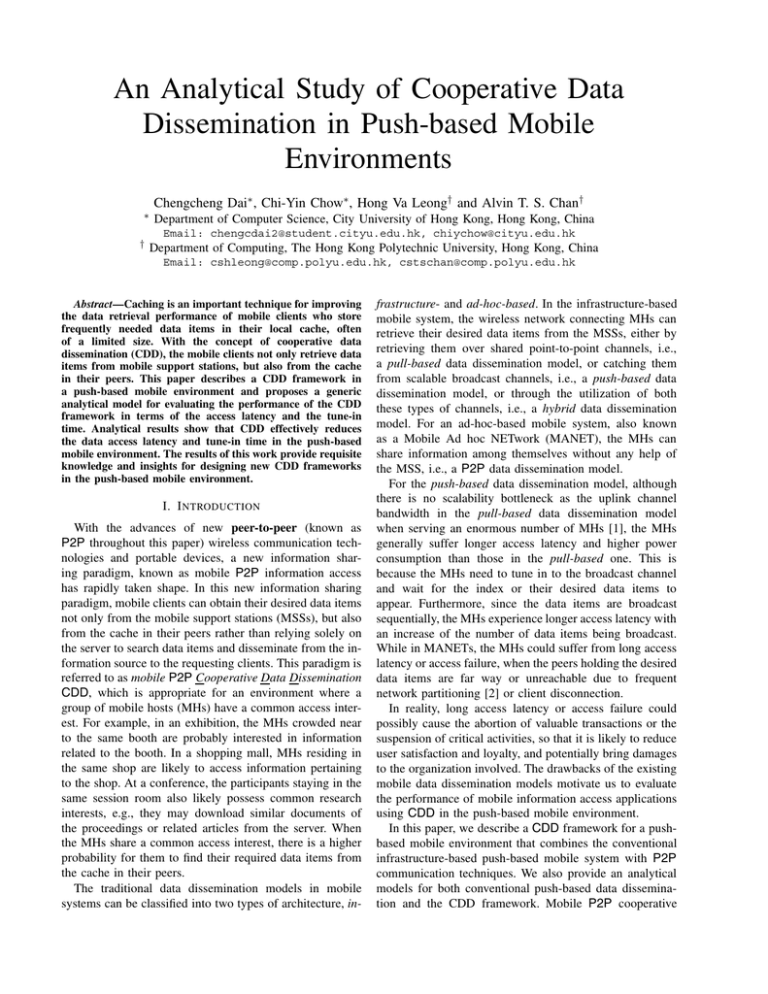
An Analytical Study of Cooperative Data
Dissemination in Push-based Mobile
Environments
∗
†
Chengcheng Dai∗ , Chi-Yin Chow∗, Hong Va Leong† and Alvin T. S. Chan†
Department of Computer Science, City University of Hong Kong, Hong Kong, China
Email: chengcdai2@student.cityu.edu.hk, chiychow@cityu.edu.hk
Department of Computing, The Hong Kong Polytechnic University, Hong Kong, China
Email: cshleong@comp.polyu.edu.hk, cstschan@comp.polyu.edu.hk
Abstract—Caching is an important technique for improving
the data retrieval performance of mobile clients who store
frequently needed data items in their local cache, often
of a limited size. With the concept of cooperative data
dissemination (CDD), the mobile clients not only retrieve data
items from mobile support stations, but also from the cache
in their peers. This paper describes a CDD framework in
a push-based mobile environment and proposes a generic
analytical model for evaluating the performance of the CDD
framework in terms of the access latency and the tune-in
time. Analytical results show that CDD effectively reduces
the data access latency and tune-in time in the push-based
mobile environment. The results of this work provide requisite
knowledge and insights for designing new CDD frameworks
in the push-based mobile environment.
I. I NTRODUCTION
With the advances of new peer-to-peer (known as
P2P throughout this paper) wireless communication technologies and portable devices, a new information sharing paradigm, known as mobile P2P information access
has rapidly taken shape. In this new information sharing
paradigm, mobile clients can obtain their desired data items
not only from the mobile support stations (MSSs), but also
from the cache in their peers rather than relying solely on
the server to search data items and disseminate from the information source to the requesting clients. This paradigm is
referred to as mobile P2P Cooperative Data Dissemination
CDD, which is appropriate for an environment where a
group of mobile hosts (MHs) have a common access interest. For example, in an exhibition, the MHs crowded near
to the same booth are probably interested in information
related to the booth. In a shopping mall, MHs residing in
the same shop are likely to access information pertaining
to the shop. At a conference, the participants staying in the
same session room also likely possess common research
interests, e.g., they may download similar documents of
the proceedings or related articles from the server. When
the MHs share a common access interest, there is a higher
probability for them to find their required data items from
the cache in their peers.
The traditional data dissemination models in mobile
systems can be classified into two types of architecture, in-
frastructure- and ad-hoc-based. In the infrastructure-based
mobile system, the wireless network connecting MHs can
retrieve their desired data items from the MSSs, either by
retrieving them over shared point-to-point channels, i.e.,
a pull-based data dissemination model, or catching them
from scalable broadcast channels, i.e., a push-based data
dissemination model, or through the utilization of both
these types of channels, i.e., a hybrid data dissemination
model. For an ad-hoc-based mobile system, also known
as a Mobile Ad hoc NETwork (MANET), the MHs can
share information among themselves without any help of
the MSS, i.e., a P2P data dissemination model.
For the push-based data dissemination model, although
there is no scalability bottleneck as the uplink channel
bandwidth in the pull-based data dissemination model
when serving an enormous number of MHs [1], the MHs
generally suffer longer access latency and higher power
consumption than those in the pull-based one. This is
because the MHs need to tune in to the broadcast channel
and wait for the index or their desired data items to
appear. Furthermore, since the data items are broadcast
sequentially, the MHs experience longer access latency with
an increase of the number of data items being broadcast.
While in MANETs, the MHs could suffer from long access
latency or access failure, when the peers holding the desired
data items are far way or unreachable due to frequent
network partitioning [2] or client disconnection.
In reality, long access latency or access failure could
possibly cause the abortion of valuable transactions or the
suspension of critical activities, so that it is likely to reduce
user satisfaction and loyalty, and potentially bring damages
to the organization involved. The drawbacks of the existing
mobile data dissemination models motivate us to evaluate
the performance of mobile information access applications
using CDD in the push-based mobile environment.
In this paper, we describe a CDD framework for a pushbased mobile environment that combines the conventional
infrastructure-based push-based mobile system with P2P
communication techniques. We also provide an analytical
models for both conventional push-based data dissemination and the CDD framework. Mobile P2P cooperative
data dissemination strategies for mobile clients have been
well studied. However, there still lacks a generic analytical model for studying the system performance of the
CDD framework in the push-based mobile environment.
For example, given local and global cache hit ratios of a
mobile P2P cooperative data dissemination strategy, we
can derive the access latency and tune-in time from our
analytical model with respect to various system settings,
e.g., the number of users and the P2P communication
bandwidth. Analytical results show that CDD effectively
reduces the data access latency and tune-in time in the
push-based mobile environment. The results of this work
provide requisite knowledge and insights for designing new
CDD frameworks in the push-based mobile environment.
The rest of this paper is organized as follows. Section II
highlights related work. The system model and analytical
model of the CDD framework in the push-based mobile environment are described in Sections III and IV, respectively.
Section V presents analytical results. Finally, Section VI
concludes this paper.
desired data item from its peers within the optimal search
radius. A cocktail cache resolution scheme is proposed for
MHs to locate their desired data items in MANETs [8].
Resource discovery services have also been designed for
MANETs [9]–[11], where they simply disseminate queries
and resource information in the network. Once a match
between a query and an available resource is found, the
resource information is sent back to the sender of the
matched query. There are also cooperative semantic caching
schemes that are designed to support location-based query
processing [12]–[15].
This paper distinguishes itself from previous work that
it presents an analytical model to evaluate the performance
of the CDD framework in the push-based mobile environment in terms of the access latency and the tune-in
time to the broadcast channel. The results of this work
provide requisite knowledge and insights for designing new
mobile applications using CDD in the push-based mobile
environment.
II. R ELATED W ORK
In this section, we present the system model of our CDD
framework and a P2P (i.e., peer-to-peer) data dissemination
protocol. There are three possible outcomes of each client
request in the CDD framework. (1) Local Cache Hit
(LCH). If an MH finds its required data item in its local
cache, a local cache hit takes place; otherwise, it is a local
cache miss. (2) Global Cache Hit (GCH). When the MH
encounters a local cache miss, it attempts to retrieve the
data item from its peers. If a peer can turn in the data
item to the MH, it constitutes a GCH. (3) Cache Miss (or
Server Request). If the MH fails to achieve neither a LCH
nor a GCH, i.e., a cache miss, it accesses the required data
item from the MSS.
In the CDD framework, each MH is equipped with two
wireless network interface cards (NICs) supporting dual
bands, i.e., 2.4GHz 802.11b/g and 5GHz 802.11a (e.g.,
Linksys wireless dual-band adapter [16]). These two NICs
are tuned to different, non-interfering channels [17]–[19];
one is dedicated to communicate with the MSS, while
the other one is devoted to communicate with other MHs.
Furthermore, there are two P2P communication paradigms:
point-to-point and broadcast. In the P2P point-to-point
communication, there is only one destination MH for the
message being sent from a source MH. In the P2P broadcast communication, all MHs residing in the transmission
range of a source MH receive the broadcast message.
The proposed P2P data dissemination protocol consists
of three types of messages: request, reply and retrieve.
A request message contains a unique identifier that is
formed by a combination of the user identifier (ID) and the
request time (TS), i.e., ID, TS. The peers only process a
request with the same identifier once, and they simply drop
duplicate requests. The key idea of the data dissemination
protocol is that when an MH encounters a local cache miss,
it broadcasts a request message to its neighboring peers. If
The related work in CDD mainly focuses on how to
search data items, and how to disseminate them from the
source MH or the MSS to the requesting MH. An intuitive cooperative data dissemination framework has been
proposed for MANETs, in which if an MH can connect
directly to an MSS, it retrieves the required data item
from the MSS; otherwise, it has to enlist other peers
that are closer to the MH than the MSS for help to
turn in the required data item [3]. If no peer caches the
required data item, the request is routed to the nearest MSS.
Another similar cooperative data dissemination framework
has been proposed to support continuous media access
in MANETs [4]. In this framework, proactive and ondemand data location schemes are designed for the MHs to
determine the nearest data source to retrieve their required
multimedia objects. Wang and Li have proposed three
cooperative data dissemination schemes, namely, CacheData, CachePath, and HybridCache [5]. The key idea of
CacheData is that an MH caches a passing-by data item, if
the data item satisfies certain conditions. The MH adopting
CachePath caches the path information of the passing-by
data item instead of the data item. HybridCache is a hybrid
scheme which combines both CacheData and CachePath.
The 7DS scheme has been proposed as a complement
to the infrastructure support with power conservation [6].
When an MH fails to connect to the Internet to retrieve the
desired data item, it attempts to search its neighboring 7DS
peers for the data item. The proposed power conservation
scheme adjusts the MHs’ degree of activity or participation
in cooperative data dissemination based on their battery
levels. Another power conservation, called ECOR, has
been proposed for MHs [7], where they exchange the
cache content and the optimal search radius (in hops) of
each cached data item among them. The MH can get its
III. S YSTEM M ODEL
TABLE I
S YMBOLS USED IN THE ANALYTICAL MODEL
Service Area of the System
Transmission Range of an MH
Symbol
PL
PG
P InitR
m4
m3
m5
MSS
m2
m6
m1
Wireless Communication
|request|
|reply|
|retrieve|
|data|
BWP ush
T PP 2P
InitR
P robe
Search
Fig. 1.
System architecture of the CDD framework.
the neighbour caches the required data item, it sends a reply
message to the MH directly. Otherwise, it simply drops the
request message. After the requesting MH receives the
reply message from the peer, it sends a retrieve message
to the peer, and then the peer turns in the required data
item to the MH. If the requesting MH receives multiple
reply messages, it selects one peer to turn in the required
data item based on certain criteria, e.g., response time and
battery power. Figure 1 depicts the system architecture of
CDD. When an MH m2 encounters a local cache miss, m2
broadcasts a request to its neighboring peers, i.e., m1 and
m3 . If m1 or m3 can turn in the required data item to m2 ,
a GCH is recorded; otherwise, m2 encounters a cache miss,
so it enlists the MSS for help.
Retrieve
Doze
Index
Data
LHit
P 2P
LReply
P 2P
D
B
Bc
S
h
n
N
m
|disk|
disk sizei
rel f reqi
Δ
θ
fi
Pi
Meaning
The probability of a local cache miss
The probability of a global cache miss
The probability of accessing a data item from the broadcast
channel before the index
The size of a request message
The size of a reply message
The size of a retrieve message
The size of a data item
The broadcast channel bandwidth in the push mobile environment
Peer-to-peer throughput capacity per MH
The time from the MH tunes in to the broadcast channel to the
time when the required data item appears in the channel before
the index
The time from the MH tunes in to the broadcast channel to the
time when the next index is broadcast
The time from the MH gets the index to the time when the MH
finds the arrival time of the required data item
The time the MH spends on downloading the required data item
from the broadcast channel
The time duration of the MH in the doze mode
The number of buckets for one complete index tree
The number of buckets for data items between two successive
complete index trees
The latency of a global cache hit
The latency of getting a reply message for a global cache search
The number of data items
The number of buckets for a data item
The number of buckets for the data items in a broadcast cycle
(excluding the index)
Bucket size
The height of an index tree
The number of index attributes in a bucket
The number of MHs
The number of complete index trees in a broadcast cycle
The number of broadcast disks
The size of a broadcast disk i
The relative frequency of a broadcast disk i
The number of hottest data items switched to the slowest
broadcast disk
Skewness parameter for Zipf distribution
The broadcast frequency of a data item i
The access probability of a data item i
IV. A NALYTICAL M ODELS
In this section, we first describe the storage hierarchy and
the CDD framework in the push-based mobile environment
and analyze its data access latency and tune-in time. Table I
depicts the meaning of the symbols used in the analytical
models.
Mobile Client Cache
Mobile Client Cache
Wireless Communication
Wireless Communication
Broadcast Channel
Broadcast Wireless
Peer Cache
Channel Communication
Mobile Support Station Disk
Mobile Support Station Disk
(a) Conventional
(b) CDD
A. Storage hierarchy
The storage hierarchy of the push-based mobile environment consists of three layers: Mobile Client Cache,
Broadcast Channel and MSS Disk, as depicted in Figure 2a. The MSS grabs the data items from a disk or
a database server, and allocates them to the broadcast
channel. If an MH encounters a local cache miss, it tunes
in to the broadcast channel, and catches the required data
item when the data item appears in the broadcast channel. In
CDD, we insert the Peer Cache layer as a supplementary
component of the Broadcast Channel layer, as shown in
Figure 2b. When an MH encounters a local cache miss, it
tunes in to the broadcast channel; meanwhile, it searches
the Peer Cache layer for the required data item. A GCH
occurs, when some neighbours can return the required
data item to the MH before the data item appears in the
broadcast channel. Otherwise, the MH has to wait for the
Fig. 2.
Storage hierarchy of the push-based mobile environment.
data item to appear in the broadcast channel, as in the
conventional scheme.
B. Broadcast scheduling algorithm
The conventional scheme and CDD in the pushbased mobile environment are analyzed with the broadcast disk [20] broadcast scheduling algorithm. To reduce
power consumption, we employ the (1, m)-Indexing technique [21], which is an index allocation scheme that evenly
broadcasts a complete index m times in a broadcast cycle.
The access latency (Access) and tune-in time (Tune) of the
broadcast disk algorithm are:
Access = InitR or (P robe + Search + Doze + Retrieve)
T une = InitR or (P robe + Search + Retrieve)
where InitR is the duration from the time when the MH
tunes in to the broadcast channel to the time when the
required data item appears in the channel before the index;
Probe is the duration from the time when the MH tunes in
to the broadcast channel to the time when the next index
is broadcast; Search is the duration from the time when
the MH gets the index to the time when it figures out the
arrival time of the required data item by following a list
of pointers; Doze is how long the MH stays in the doze
mode, after it determines the arrival time of its required
data item; and Retrieve is the time for the MH to download
the required data item from the broadcast channel.
Let S denote a bucket size, D denote the total number
of data items, B denote the number of buckets for a data
item (i.e., B = |data|
S ), and Bc denote the total number
of buckets for the data items in a broadcast cycle (i.e.,
excluding the buckets for the index). Furthermore, let h
and n be the height of the index tree and the number of
index attributes that a bucket can hold, respectively. Finally,
let Index and Data be the number of buckets occupied by
the index tree and the number of buckets occupied by the
data items between two successive index trees, respectively.
Since a complete index is evenly broadcast m times in a
broadcast cycle, i.e., Data = Bmc . When an index tree is
h−1
fully balanced, h = logn (D) and Index = i=0 ni .
C. Analytical Models
i.e., the relative frequencies of disk1 , disk2 , . . . , disk|disk|
are rel f req1 , rel f req2 , . . . , rel f req|disk| , respectively,
where rel f req1 ≥ rel f req2 ≥ . . . ≥ rel f req|disk| .
The broadcast frequency fi of each data item di based on
the index i is as follows:For Δ < i ≤ disk size1 + Δ,
k−1
fi = rel f req1 . For
j=1 disk sizej + Δ < i ≤
k
disk
size
+
Δ,
f
j
i = rel f reqk where 1 <
j=1
|disk|−1
disk sizej + Δ < i ≤
k < |disk|. For
j=1
|disk|
j=1 disk sizej or 1 ≤ i ≤ Δ, fi = rel f req|disk| .
The expected number of buckets before the arrival of
c
the desired data item is Index×m+B
[23]. The number
2×fi
of buckets for data items in a broadcast cycleexcluding
D
the index trees is Bc = Data × m = B × i=1 fi =
|disk|
B × i=1 disk sizei ×rel f reqi . Hence, InitR, P robe,
Search, Doze and Retrieve in the push-based mobile
environment are:
1
S
× (Index + Data) + B) ×
2
BWP ush
1
S
P robe = × (Index + Data) ×
2
BWP ush
S
Search =(h + 1) ×
BWP ush
Index × m + Bc
S
Doze =
×
2 × fi
BWP ush
S
Retrieve =B ×
BWP ush
InitR =(
Since some data items are broadcast more than once in
a broadcast cycle, P InitR , the probability of accessing a
data item from the broadcast channel before the index, is
based on the broadcast frequency fi of a data item di :
P InitR =
We here consider the following two parameters to evaluate the efficiency of data dissemination: a. Access Latency.
The expected time from the time a client requests a data
item to the time the client obtains the data item. b. Tuning
time. The amount of time spent by a client listening to the
channel. This will determine the power consumption of a
client to retrieve the required data.
Conventional scheme. The broadcast disk algorithm partitions all data items into several ranges. Each range that
contains the data items with similar access probabilities
is referred to as a disk. Also, each disk, diski , with
size, disk sizei , has its own relative broadcast frequency,
rel f reqi . The larger the relative broadcast frequency
rel f req, the higher the disk spinning speed. The hottest
data items are allocated to the disk with the highest
rel f req. Likewise, the coldest data items are arranged
to the disk with the slowest rel f req. Since most MHs
cache the hottest data items, the most Δ hottest data
items are shifted to the slowest rel f req to obtain better performance [20]. For simplicity, we assume the access pattern follows the Zipf distribution with a skewness parameter θ [22], so the access probability of a
data item di is Pi = iθ D1 1 . |disk| disks are used,
j=1 j θ
fi
Index
Data
×[
+
×
m
Index + Data
Index + Data
Data/B
i=1
(
1
i
×
)]
Data/B
Data/B
Accessnc and Tunenc of the conventional scheme in the
push-based mobile environment are:
Accessnc =
D
{P InitR × InitR + (1 − P InitR )×
i=1
(P robe + Search + Doze + Retrieve)} × Pi
T unenc =
D
{P InitR × InitR + (1 − P InitR )×
i=1
(P robe + Search + Retrieve)} × Pi
Cooperative data dissemination (CDD). In CDD, we
consider that each MH’s device has the same transmission
range with a fixed bandwidth in a network with random
traffic patterns, hence the throughput capacity per MH
P2P
) [24]. We further assume that
is T PP2P = Θ( √BW
N log N
the processing time of handling a global cache query is
negligible and the latency of a global cache access depends
on the transmission time. Thus, the latency of a global
|request|+|reply|+|retrieve|+|data|
cache hit is LHit
.
P2P =
T PP2P
1
15
10
Non−CDD
CDD(GCH=0.1)
CDD(GCH=0.2)
CDD(GCH=0.3)
CDD(GCH=0.4)
CDD(GCH=0.5)
5
0
100
200
300
400
500
Tune−in Time (in seconds)
D = 10K, PL = 0.05, PG = 0.1 to 0.5, θ = 0.5
n = 10, Δ = 100, m = 30, S = 64bytes
rel f req1,2,3 = 3, 2, 1, disk size1,2,3 = 1K, 3K, 6K
|disk| = 3, h = 4, N = 500, |data| = 4KB
|reply| = |request| = |retrieve| = 64bytes
BWP ush = 10Mbps, BWP 2P = 2Mbps
20
Access Latency (in seconds)
TABLE II
PARAMETER SETTINGS OF THE ANALYTICAL MODELS .
0.8
0.6
0.4
Non−CDD
CDD(GCH=0.1)
CDD(GCH=0.2)
CDD(GCH=0.3)
CDD(GCH=0.4)
CDD(GCH=0.5)
0.2
0
600
100
200
300
Number of MHs
T unecdd =(1 − PL ) × {PG ×
min(LReply
P 2P , T unenc )+
(1 − PG ) × T unenc },
Fig. 3.
30
20
15
10
5
0
6
8
10
12
14
Broadcast Channel Bandwidth (Mbps)
|request|+|reply|
where LReply
. Since LReply
P 2P =
P 2P is relatively
TPP 2P
much smaller than T unenc and LHit
P 2P is also substantially
smaller than Accessnc , we consider that LReply
(LHit
P 2P )
P 2P
is the minimum value compared with T unenc (Accessnc ).
Thus, Accesscdd and T unecdd can be simplified, without
loss of generality, as follows:
Accesscdd =(1 − PL ) × {PG × LHit
P 2P + (1 − PG ) × Accessnc }
T unecdd =(1 − PL ) × {PG × LReply
P 2P + (1 − PG ) × T unenc }
V. A NALYTICAL R ESULTS
(a) Access Latency
Fig. 4.
600
The number of MHs.
Non−CDD
CDD(GCH=0.1)
CDD(GCH=0.2)
CDD(GCH=0.3)
CDD(GCH=0.4)
CDD(GCH=0.5)
25
500
(b) Tune-in Time
1.5
Tune−in Time (in seconds)
Accesscdd =(1 − PL ) × {PG × min(LHit
P 2P , Accessnc )+
(1 − PG ) × Accessnc }
(a) Access Latency
Access Latency (in seconds)
If the MH of CDD can get its required data item from
its neighbour before the data item appears in the broadcast
channel, the access latency can be improved. Likewise, the
tune-in time can be reduced, if the MH receives a reply
message before the index is being broadcast. Thus, the
access latency and tune-in time of CDD with the broadcast
disk algorithm are:
400
Number of MHs
Non−CDD
CDD(GCH=0.1)
CDD(GCH=0.2)
CDD(GCH=0.3)
CDD(GCH=0.4)
CDD(GCH=0.5)
1
0.5
0
6
8
10
12
14
Broadcast Channel Bandwidth (Mbps)
(b) Tune-in Time
The broadcast channel bandwidth (BWP ush ).
that CDD also reduces the tune-in time, as the GCH
ratio increases. However, increasing the number of MHs
degrades the throughput of the P2P communication that
leads to a higher tune-in time. Since the power consumption
is proportional to the tune-in time, the MHs adopting CDD
experiencing a shorter tune-in time can save more power.
Therefore, CDD is also a power conservation technique in
the push-based mobile environment.
In this section, we present the analytical results for
the conventional approach (i.e., non-CDD) and the CDD
framework in the push-based mobile environment with the
broadcast disk scheduling algorithm [20] and the (1, m)Indexing technique [21]. The performance of CDD is
evaluated with respect to various system settings and given
global cache hit (GCH) ratios in terms of the access latency
and the tune-in time to the broadcast channel. Table II gives
the parameter settings for the analytical models.
Figures 4a and 4b depict the access latency and the
tune-in time of non-CDD and CDD with an increase of
the bandwidth of the broadcast channel (i.e., BWP ush )
from 6 to 14 Mbps, respectively. Figure 4a shows that
both non-CDD and CDD give better access latency when
BWP ush increases. This is because it is faster for the MSS
to broadcast both data items and indexes.
A. Effect of the Number of MHs
C. Effect of Peer-to-Peer (P2P) Channel Bandwidth
Figures 3a and 3b depict the access latency and the tunein time of non-CDD and CDD with respect to various
numbers of MHs from 100 to 600, respectively. Figure 3a
shows that CDD gives better access latency than non-CDD
as the GCH ratio gets higher. However, the access latency
of CDD slightly gets worse, when there are more MHs in
the system. This is due to the fact that the throughput of
the P2P communication reduces as the number of MHs
rises. Thus, CDD is a scalable and effective technique
for improving the data access latency. Figure 3b shows
Figures 5a and 5b depict the access latency and the tunein time with an increase of the bandwidth of the P2P
channel (i.e., BWP 2P ) from 1 to 5 Mbps, respectively.
Since non-CDD does not involve any peer cooperation, its
performance is not affected by varying BWP 2P . Figure 5a
shows that the access latency of CDD decreases as the
BWP 2P increases. This is because the throughput of P2P
communication increases as BWP 2P rises. CDD gives
better access latency than non-CDD as the GCH ratio gets
higher because the MH is more likely to get its required
B. Effect of Broadcast Channel Bandwidth
1
15
10
Non−CDD
CDD(GCH=0.1)
CDD(GCH=0.2)
CDD(GCH=0.3)
CDD(GCH=0.4)
CDD(GCH=0.5)
5
0
1
2
3
4
Tune−in Time (in seconds)
Access Latency (in seconds)
20
0.8
ACKNOWLEDGEMENT
0.6
0.4
Non−CDD
CDD(GCH=0.1)
CDD(GCH=0.2)
CDD(GCH=0.3)
CDD(GCH=0.4)
CDD(GCH=0.5)
0.2
0
5
mobile environment and the empirical study of the CDD
framework.
1
P2P Channel Bandwidth (Mbps)
(a) Access Latency
Fig. 5.
2.5
30
20
10
0
1
2
4
4
5
The P2P channel bandwidth (BWP 2P ).
Non−CDD
CDD(GCH=0.1)
CDD(GCH=0.2)
CDD(GCH=0.3)
CDD(GCH=0.4)
CDD(GCH=0.5)
40
3
(b) Tune-in Time
Tune−in Time (in seconds)
Access Latency (in seconds)
50
2
P2P Channel Bandwidth (Mbps)
6
8
10
Non−CDD
CDD(GCH=0.1)
CDD(GCH=0.2)
CDD(GCH=0.3)
CDD(GCH=0.4)
CDD(GCH=0.5)
2
1.5
1
0.5
0
1
2
Data Item Size (KB)
(a) Access Latency
Fig. 6.
4
6
8
10
Data Item Size (KB)
(b) Tune-in Time
The size of data items (|data|).
data item from peers before the data item appears in the
broadcast channel. Figure 5b shows that CDD also reduces
the tune-in time when the GCH ratio increases.
D. Effect of the Size of Data Items
Figures 6a and 6b depict that both the access latency and
the tune-in time of non-CDD and CDD get higher as data
item size increases from 1 to 10 KB, respectively. The main
reason is that when the data item size gets larger, both the
MSS and MHs take more time to broadcast and send a data
item, respectively. Since retrieving a data item or getting a
reply message from peers is usually before the data item or
index appears in the broadcast channel, CDD gives better
access latency and tune-in time than non-CDD as the GCH
ratio rises.
VI. C ONCLUSION
In this paper, we have presented the cooperative data
dissemination (CDD) framework in the push-based mobile
environment. In CDD, the mobile hosts can get their
required data items not only from the mobile base station,
but also from their peers. We have also proposed the
analytical models to evaluate the system performance of the
conventional approach and the CDD framework. Analytical
results show that CDD is more efficient than the conventional approach in the push-based mobile environment in
terms of both the access latency and the tune-in time to
the broadcast channel. Our future directions will focus on
the analytical study of CDD in the pull-based and hybrid
The work described in this paper was partially supported
by grants from City University of Hong Kong (Project No.
7002867, 7002722, and 7002686).
R EFERENCES
[1] S. Acharya, M. Franklin, and S. Zdonik, “Balancing push and pull
for data broadcast,” in ACM SIGMOD, 1997.
[2] K. H. Wang and B. Li, “Efficient and guaranteed service coverage
in partitionable mobile ad-hoc networks,” in IEEE Infocom, 2002.
[3] F. Sailhan and V. Issarny, “Cooperative caching in ad hoc networks,”
in MDM, 2003.
[4] W. H. O. Lau, M. Kumar, and S. Venkatesh, “A cooperative cache
architecture in support of caching multimedia objects in MANETs,”
in WoWMoM, 2002.
[5] L. Yin and G. Cao, “Supporting cooperative caching in ad hoc
networks,” IEEE TMC, vol. 5, no. 1, pp. 77–89, 2006.
[6] M. Papadopouli and H. Schulzrinne, “Effects of power conservation,
wireless coverage and cooperation on data dissemination among
mobile devices,” in ACM MobiHoc, 2001.
[7] H. Shen, S. K. Das, M. Kumar, and Z. Wang, “Cooperative caching
with optimal radius in hybrid wireless network,” in IFIP NETWORKING, 2004.
[8] Y. Du and S. K. S. Gupta, “COOP - A cooperative caching service
in MANETs,” in IARIA ICNS, 2005.
[9] U. Lee, J. Lee, J.-S. Park, and M. Gerla, “FleaNet: A virtual market
place on vehicular networks,” IEEE TVT, vol. 59, no. 1, pp. 344–355,
2010.
[10] O. Wolfson, B. Xu, and R. M. Tanner, “Mobile peer-to-peer data
dissemination with resource constraints,” in MDM, 2007.
[11] X. Zhu, B. Xu, and O. Wolfson, “Spatial queries in disconnected
mobile networks,” in ACM GIS, 2008.
[12] C.-Y. Chow, M. F. Mokbel, and H. V. Leong, “On efficient and
scalable support of continuous queries in mobile peer-to-peer environments,” IEEE TMC, vol. 10, no. 10, pp. 1473–1487, 2011.
[13] W.-S. Ku, R. Zimmermann, and H. Wang, “Location-based spatial
query processing in wireless broadcast environments,” IEEE TMC,
vol. 7, no. 6, pp. 778–791, 2008.
[14] F. J. Maymi, M. Rodriguez-Martinez, and W. Rolke, “A cooperative
spatial-aware cache for mobile environments,” in ACM MobiDE,
2010.
[15] Q. Zhu, D. L. Lee, and W.-C. Lee, “Collaborative caching for spatial
queries in mobile P2P networks,” in IEEE ICDE, 2011.
[16] Linksys
AE2500,
“Wireless
dual-band
USB
adapter,”
http://home.cisco.com/en-mea/products/adapters/AE2500;
Last
accessed: August 22, 2012.
[17] R. Draves, J. Padhye, and B. Zill, “Routing in multi-radio, multi-hop
wireless mesh networks,” in ACM MobiCom, 2004.
[18] B.-J. Ko, V. Misra, J. Padhye, and D. Rubenstein, “Distributed
channel assignment in multi-radio 802.11 mesh networks,” in IEEE
WCNC, 2007.
[19] J. Zhao, P. Zhang, and G. Cao, “On cooperative caching in wireless
p2p networks,” in IEEE ICDCS, 2008.
[20] S. Acharya, R. Alonso, M. Franklin, and S. Zdonik, “Broadcast
Disks: Data management for asymmetric communication environments,” in ACM SIGMOD, 1995.
[21] T. Imielinski, S. Viswanathan, and B. R. Badrinath, “Data on Air:
Organization and access,” IEEE TKDE, vol. 9, no. 3, pp. 353–372,
1997.
[22] G. K. Zipf, Human Behavior and the Principle of Least Effort.
Addison-Wesley, 1949.
[23] Q. Hu, W.-C. Lee, and D. L. Lee, “A hybrid index technique for
power efficient data broadcast,” Distributed and Parallel Databases,
vol. 9, no. 2, pp. 151–177, 2001.
[24] P. Gupta and P. Kumar, “Capacity of wireless networks,” IEEE Trans
Inf Theory, vol. 46, no. 2, pp. 388–404, 2000.

